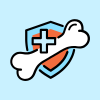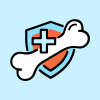Nexus Veterinary CE
Advanced Fracture Repair 1 & 2 (Baltimore Bundle)
-
Register
- Veterinarian - $5,900
Bundle and save when you register for Advanced Fracture Repair 1 and Advanced Fracture Repair 2! These courses will be held back-to-back from October 9 through October 12.
Take advantage of this 4-day course package and complete both courses during your stay in Baltimore, Maryland!
-
Includes a Live In-Person Event on 10/09/2025 at 8:00 AM (MDT)
October 9 - 10, 2025 | Baltimore, MD
Overall Course Description:
This is an advanced level course designed for practitioners that have completed the “Principles of Fracture Repair” course (or equivalent) and have experience with fracture repair. The course is one of three advanced courses designed to train veterinarians to reach a high level of expertise in veterinary orthopedics. These techniques are difficult and quite demanding. They require a firm understanding of orthopedic principles, tissue handling, use of power equipment, locking plate technique, and use of bone clamps and other orthopedic instrumentation.
Fractures of the humerus and radius/ulna are common in dogs and cats. This course will discuss decision-making, surgical approach, fracture reduction techniques and surgical repair of different types of simple and comminuted fractures of the humerus and radius/ulna.
This course is designed to take the general practitioner to a higher level in fracture repair. We will teach reliable techniques and give valuable practical tips useful in repairing simple and more challenging comminuted fractures. New implant designs have made fracture repair much simpler and more affordable. In addition, postoperative management of patients has also been simplified and complications are rare if the principles of fracture repair are followed.
This course will familiarize participants with fracture repair techniques through lecture and clinical case presentations. Following lecture and case review, participants will repair fractures on plastic bone models and cadavers. Postoperative radiographs will be taken to evaluate the participants repair technique.
Learning Objectives:
1. Understand the principles of bone healing and the differences between secondary and primary bone healing.
2. Review fracture classification and choice of fixation for fractures of the humerus and radius/ulna.
3. Discuss the concept of direct versus indirect fracture reduction and decision making on approach.
4. Learn how to correctly apply locking bone plates, plate and rod repair, lag screws and pin, Orthosta sutures and tension bands.
5. Discuss fracture fixation and surgical approaches for proximal, diaphyseal and distal fractures of the humerus, and radius/ulna.
6. Learn how to repair an ulnar fracture combined with a radial head luxation (Monteggia fracture)
Day 1
8:00am Welcome & Introductions 8:05am Direct & indirect fracture reduction: A review 8:20am Comminuted humeral shaft fractures 8:45am Humeral condylar and supracondylar fractures 9:45am Break 10:00am Laboratory 1: Demo of lateral condyle fracture repair (Cadaver) – HCS and plate 10:30am Laboratory 2: Lateral condyle fracture repair (Plastic Bone Model & R leg of Cadaver) – HCS and plate 12:00pm Lunch 12:45pm Laboratory 3: Demo of indirect reduction of humeral shaft fracture (Cadaver) – Double-Plate 1:15pm Laboratory 4: Indirect reduction of humeral shaft fracture (Plastic Bone Model & R leg of Cadaver) – Double-Plate 2:30pm Laboratory 5: Demo of supracondylar Y-fracture repair (Cadaver) – HCS and Double-Plate 3:00pm Laboratory 6: Supracondylar Y-fracture repair (Plastic Bone Model & L leg of Cadaver) – HCS and Double-Plate 5:00pm Conclusion of Day 1
Day 2
8:00am Review of Day 1 Radiographs 9:00am Break 9:15am Comminuted Radius/Ulna Shaft Fractures 9:45am Laboratory 7: Demo of indirect reduction of radius/ulna fracture (Cadaver) – Plate and Rod 10:00am Laboratory 8: Indirect reduction of radius/ulna fracture (Cadaver both legs) – Plate and Rod 12:00pm Lunch 12:45pm Ulnar Fractures and Monteggia Fractures 1:15pm Laboratory 9: Demo of Repair of articular fracture of olecranon (Cadaver) –Plate and pin 1:35pm Laboratory 10: Indirect reduction of articular fracture of olecranon (L leg of Cadaver) – Plate and pin 2:35pm Laboratory 9: Demo of Repair of Monteggia fracture (Cadaver) – Plate, Orthosta Suture 3:00pm Laboratory 10: Repair of Monteggia fracture (R leg of Cadaver) – Plate, Orthosta Suture 4:15pm Wrap-up Discussion 4:30pm Conclusion of Course -
Includes a Live In-Person Event on 10/11/2025 at 8:00 AM (EDT)
October 11 - 12, 2025 | Baltimore, MD
Overall Course Description:
This is an advanced level course designed for practitioners that have completed the “Principles of Fracture Repair” course (or equivalent) and have experience with fracture repair. The course is one of three advanced courses designed to train veterinarians to reach a high level of expertise in veterinary orthopedics. These techniques are difficult and quite demanding. They require a firm understanding of orthopedic principles, tissue handling, use of power equipment, locking plate technique, and use of bone clamps and other orthopedic instrumentation.
Fractures of the femur and tibia are common in dogs and cats. This course will discuss decision-making, surgical approach, fracture reduction techniques and surgical repair of different types of simple and comminuted fractures of the femur and tibia.
This course is designed to take the general practitioner to a higher level in fracture repair. We will teach reliable techniques and give valuable practical tips useful in repairing simple and more challenging comminuted fractures. New implant designs have made fracture repair much simpler and more affordable. In addition, postoperative management of patients has also been simplified and complications are rare if the principles of fracture repair are followed.
This course will familiarize participants with fracture repair techniques through lecture and clinical case presentations. Following lecture and case review, participants will repair fractures on plastic bone models and cadavers. Postoperative radiographs will be taken to evaluate the participants repair technique.
Learning Objectives:
1. Understand the principles of bone healing and the differences between secondary and primary bone healing.
2. Review fracture classification and choice of fixation for fractures of the femur and tibia.
3. Discuss the concept of direct versus indirect fracture reduction and decision making on approach.
4. Learn how to correctly apply locking bone plates, plate and rod repair, lag screws and pin and tension band.
5. Discuss fracture fixation and surgical approaches for proximal, diaphyseal and distal fractures of the tibia, and femur.
Day 1
8:00am Welcome & Introductions 8:05am Direct & Indirect Fracture Reduction: A Review 8:20am Femoral Head and Neck Fractures 8:50am Laboratory 1: Demo capital physeal and femoral neck fracture repair (Cadaver) – k-wires and HCS/wire 9:15am Laboratory 2: Direct reduction of capital physeal fracture (Plastic Bone Model & R leg of Cadaver) – k-wires 10:30am Laboratory 3: Direct reduction of femoral neck fracture (Plastic Bone Model & L leg of Cadaver) – HCS, k-wire 12:00pm Lunch 12:45pm Comminuted Femoral Shaft Fractures 1:15pm Laboratory 4: Demo of indirect reduction of femoral shaft fracture (Cadaver) – Plate and Rod and Double-Plate 1:30pm Laboratory 5: Indirect reduction of femoral shaft fracture (Cadaver both legs) – Plate and Rod or Double-Plate 3:15pm Distal femoral physeal and supratrochlear fractures 3:30pm Laboratory 6: Direct reduction of distal femoral physeal fracture (Cadaver R leg) – Pins 4:15pm Laboratory 7: Direct reduction of distal femoral supratrochlear fracture (Cadaver L leg) – Pins 5:00pm Conclusion of Day 1
Day 2
8:00am Review of Day 1 Radiographs 9:00am Comminuted Tibial Shaft Fractures 9:30am Laboratory 8: Demo of indirect reduction of tibial shaft fracture (Cadaver) – Plate and Rod or Double-Plate 9:45am Laboratory 9: Indirect reduction of tibial shaft fracture (Cadaver both legs) – Plate and Rod or Double-Plate 12:00pm Lunch 12:45pm Distal Tibial Fractures 1:15pm Laboratory 10: Demo of repair of distal tibial shaft fracture (Cadaver) – Double-Plate (straight and T-plate) 1:30pm Laboratory 11: Repair of distal tibial shaft fracture (Cadaver both legs) – Double-Plate (straight and T-plate) 3:15pm Tibial Tuberosity Fractures 3:30pm Laboratory 12: Demo of Direct Reduction of Tibial Tuberosity Fracture (Cadaver) – Pin and Tension Band 3:45pm Laboratory 13: Direct Reduction of Tibial Tuberosity Fracture (Cadaver both legs) – Pin and Tension Band 4:45pm Wrap up discussion 5:00pm Conclusion of Course

